Essay: Communication Methods, Language, Speech, and Child Development
VerifiedAdded on 2022/11/23
|8
|2058
|1
Essay
AI Summary
This essay explores the multifaceted realm of communication, distinguishing it from language and speech while delving into the developmental stages from infancy to school-going children. It highlights the significance of non-verbal communication, dynamic listening, and emotional awareness. The essay examines how speech, language, and communication are interconnected, detailing their distinct meanings and roles. It further discusses factors influencing communication, speech, and language development, including functional relationships, experience, social environments, and physiological conditions. The essay references the Australian curriculum, emphasizing the importance of early childhood programs and the development of communication skills through listening, speaking, reading, and writing. In conclusion, the essay underscores the critical role of communication, speech, and language in children's development, emphasizing how these skills are acquired through interactions with families, friends, and teachers.

1
Running Head: Essay
Assignment
Running Head: Essay
Assignment
Paraphrase This Document
Need a fresh take? Get an instant paraphrase of this document with our AI Paraphraser
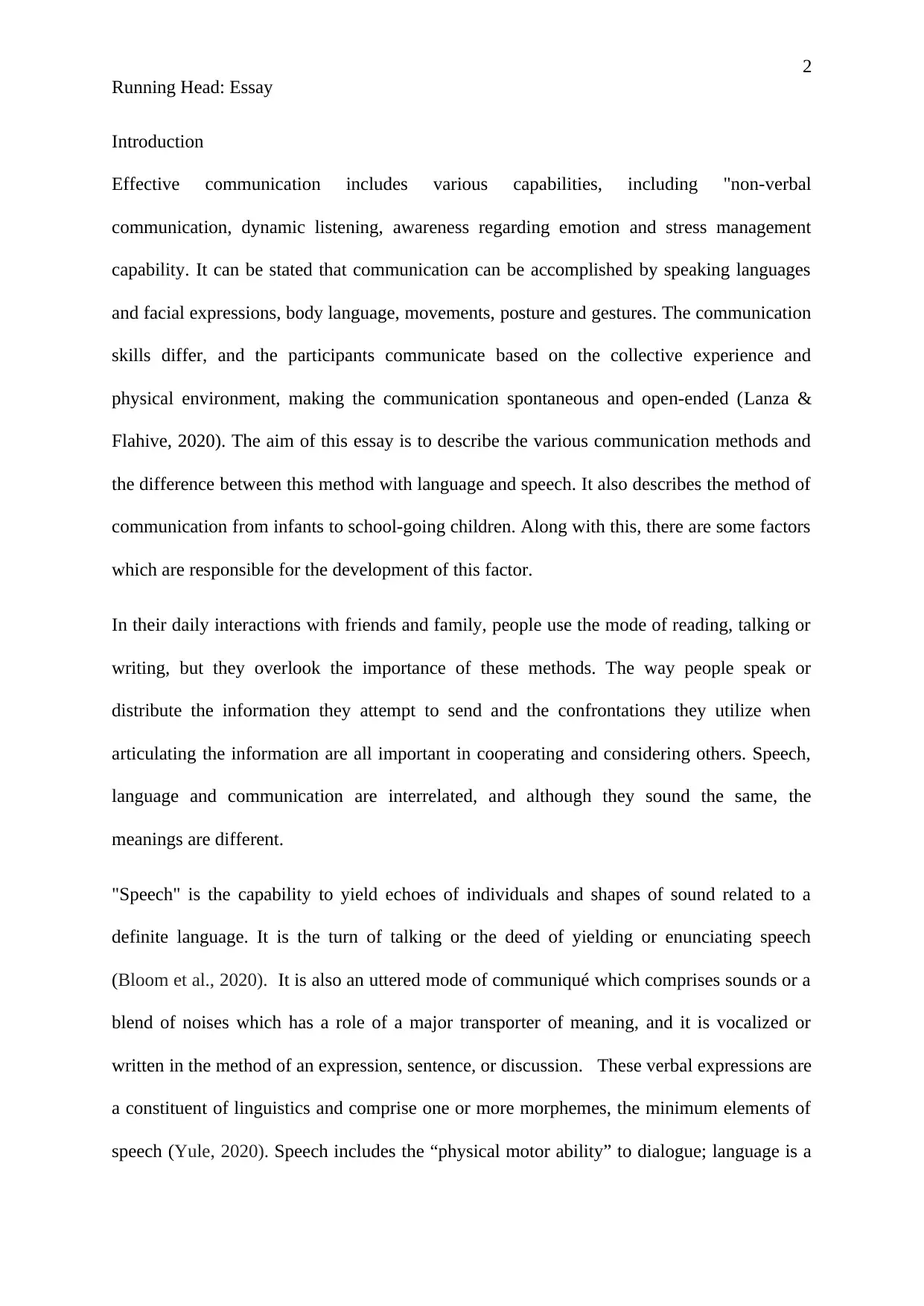
2
Running Head: Essay
Introduction
Effective communication includes various capabilities, including "non-verbal
communication, dynamic listening, awareness regarding emotion and stress management
capability. It can be stated that communication can be accomplished by speaking languages
and facial expressions, body language, movements, posture and gestures. The communication
skills differ, and the participants communicate based on the collective experience and
physical environment, making the communication spontaneous and open-ended (Lanza &
Flahive, 2020). The aim of this essay is to describe the various communication methods and
the difference between this method with language and speech. It also describes the method of
communication from infants to school-going children. Along with this, there are some factors
which are responsible for the development of this factor.
In their daily interactions with friends and family, people use the mode of reading, talking or
writing, but they overlook the importance of these methods. The way people speak or
distribute the information they attempt to send and the confrontations they utilize when
articulating the information are all important in cooperating and considering others. Speech,
language and communication are interrelated, and although they sound the same, the
meanings are different.
"Speech" is the capability to yield echoes of individuals and shapes of sound related to a
definite language. It is the turn of talking or the deed of yielding or enunciating speech
(Bloom et al., 2020). It is also an uttered mode of communiqué which comprises sounds or a
blend of noises which has a role of a major transporter of meaning, and it is vocalized or
written in the method of an expression, sentence, or discussion. These verbal expressions are
a constituent of linguistics and comprise one or more morphemes, the minimum elements of
speech (Yule, 2020). Speech includes the “physical motor ability” to dialogue; language is a
Running Head: Essay
Introduction
Effective communication includes various capabilities, including "non-verbal
communication, dynamic listening, awareness regarding emotion and stress management
capability. It can be stated that communication can be accomplished by speaking languages
and facial expressions, body language, movements, posture and gestures. The communication
skills differ, and the participants communicate based on the collective experience and
physical environment, making the communication spontaneous and open-ended (Lanza &
Flahive, 2020). The aim of this essay is to describe the various communication methods and
the difference between this method with language and speech. It also describes the method of
communication from infants to school-going children. Along with this, there are some factors
which are responsible for the development of this factor.
In their daily interactions with friends and family, people use the mode of reading, talking or
writing, but they overlook the importance of these methods. The way people speak or
distribute the information they attempt to send and the confrontations they utilize when
articulating the information are all important in cooperating and considering others. Speech,
language and communication are interrelated, and although they sound the same, the
meanings are different.
"Speech" is the capability to yield echoes of individuals and shapes of sound related to a
definite language. It is the turn of talking or the deed of yielding or enunciating speech
(Bloom et al., 2020). It is also an uttered mode of communiqué which comprises sounds or a
blend of noises which has a role of a major transporter of meaning, and it is vocalized or
written in the method of an expression, sentence, or discussion. These verbal expressions are
a constituent of linguistics and comprise one or more morphemes, the minimum elements of
speech (Yule, 2020). Speech includes the “physical motor ability” to dialogue; language is a
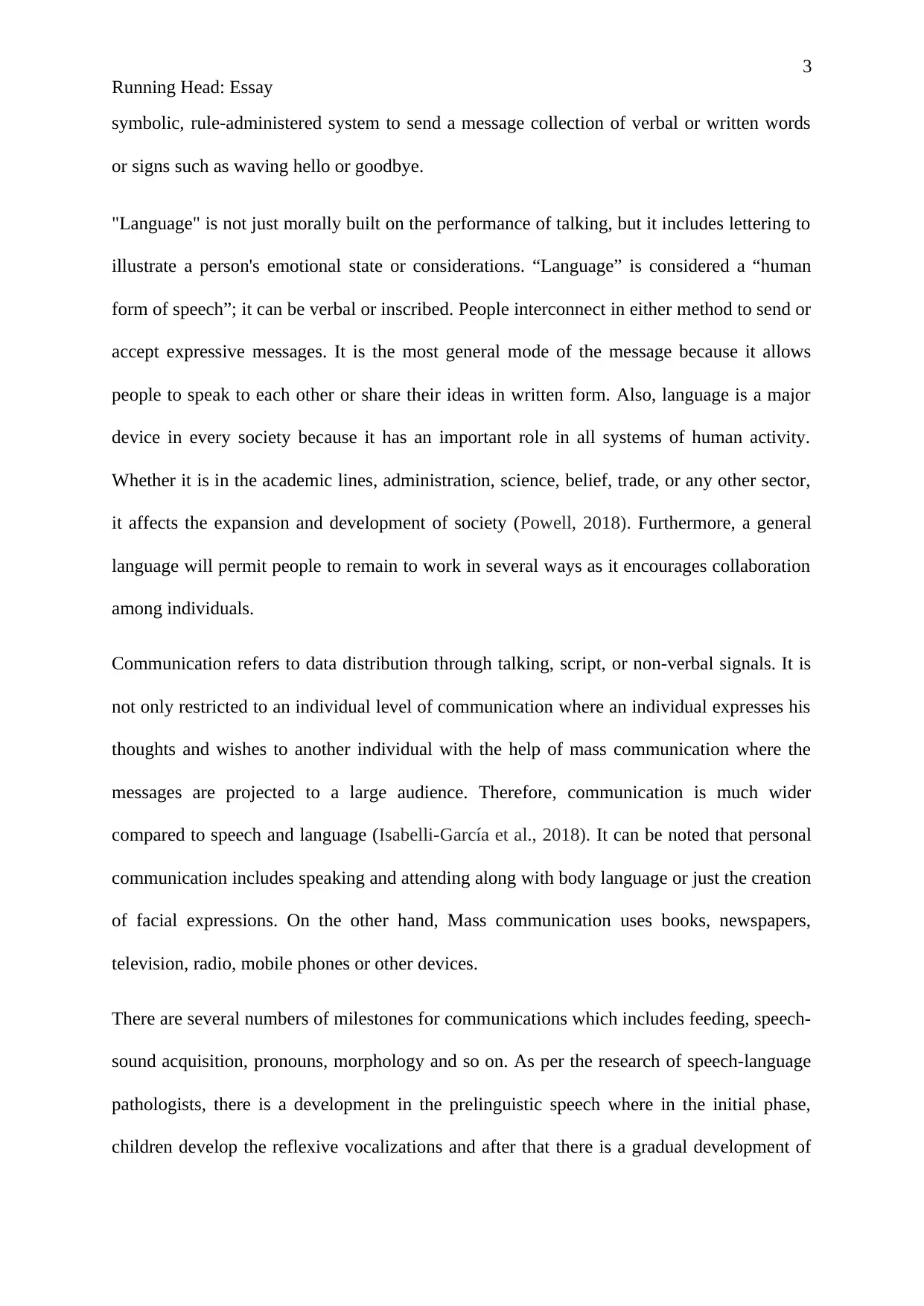
3
Running Head: Essay
symbolic, rule-administered system to send a message collection of verbal or written words
or signs such as waving hello or goodbye.
"Language" is not just morally built on the performance of talking, but it includes lettering to
illustrate a person's emotional state or considerations. “Language” is considered a “human
form of speech”; it can be verbal or inscribed. People interconnect in either method to send or
accept expressive messages. It is the most general mode of the message because it allows
people to speak to each other or share their ideas in written form. Also, language is a major
device in every society because it has an important role in all systems of human activity.
Whether it is in the academic lines, administration, science, belief, trade, or any other sector,
it affects the expansion and development of society (Powell, 2018). Furthermore, a general
language will permit people to remain to work in several ways as it encourages collaboration
among individuals.
Communication refers to data distribution through talking, script, or non-verbal signals. It is
not only restricted to an individual level of communication where an individual expresses his
thoughts and wishes to another individual with the help of mass communication where the
messages are projected to a large audience. Therefore, communication is much wider
compared to speech and language (Isabelli-García et al., 2018). It can be noted that personal
communication includes speaking and attending along with body language or just the creation
of facial expressions. On the other hand, Mass communication uses books, newspapers,
television, radio, mobile phones or other devices.
There are several numbers of milestones for communications which includes feeding, speech-
sound acquisition, pronouns, morphology and so on. As per the research of speech-language
pathologists, there is a development in the prelinguistic speech where in the initial phase,
children develop the reflexive vocalizations and after that there is a gradual development of
Running Head: Essay
symbolic, rule-administered system to send a message collection of verbal or written words
or signs such as waving hello or goodbye.
"Language" is not just morally built on the performance of talking, but it includes lettering to
illustrate a person's emotional state or considerations. “Language” is considered a “human
form of speech”; it can be verbal or inscribed. People interconnect in either method to send or
accept expressive messages. It is the most general mode of the message because it allows
people to speak to each other or share their ideas in written form. Also, language is a major
device in every society because it has an important role in all systems of human activity.
Whether it is in the academic lines, administration, science, belief, trade, or any other sector,
it affects the expansion and development of society (Powell, 2018). Furthermore, a general
language will permit people to remain to work in several ways as it encourages collaboration
among individuals.
Communication refers to data distribution through talking, script, or non-verbal signals. It is
not only restricted to an individual level of communication where an individual expresses his
thoughts and wishes to another individual with the help of mass communication where the
messages are projected to a large audience. Therefore, communication is much wider
compared to speech and language (Isabelli-García et al., 2018). It can be noted that personal
communication includes speaking and attending along with body language or just the creation
of facial expressions. On the other hand, Mass communication uses books, newspapers,
television, radio, mobile phones or other devices.
There are several numbers of milestones for communications which includes feeding, speech-
sound acquisition, pronouns, morphology and so on. As per the research of speech-language
pathologists, there is a development in the prelinguistic speech where in the initial phase,
children develop the reflexive vocalizations and after that there is a gradual development of
⊘ This is a preview!⊘
Do you want full access?
Subscribe today to unlock all pages.

Trusted by 1+ million students worldwide
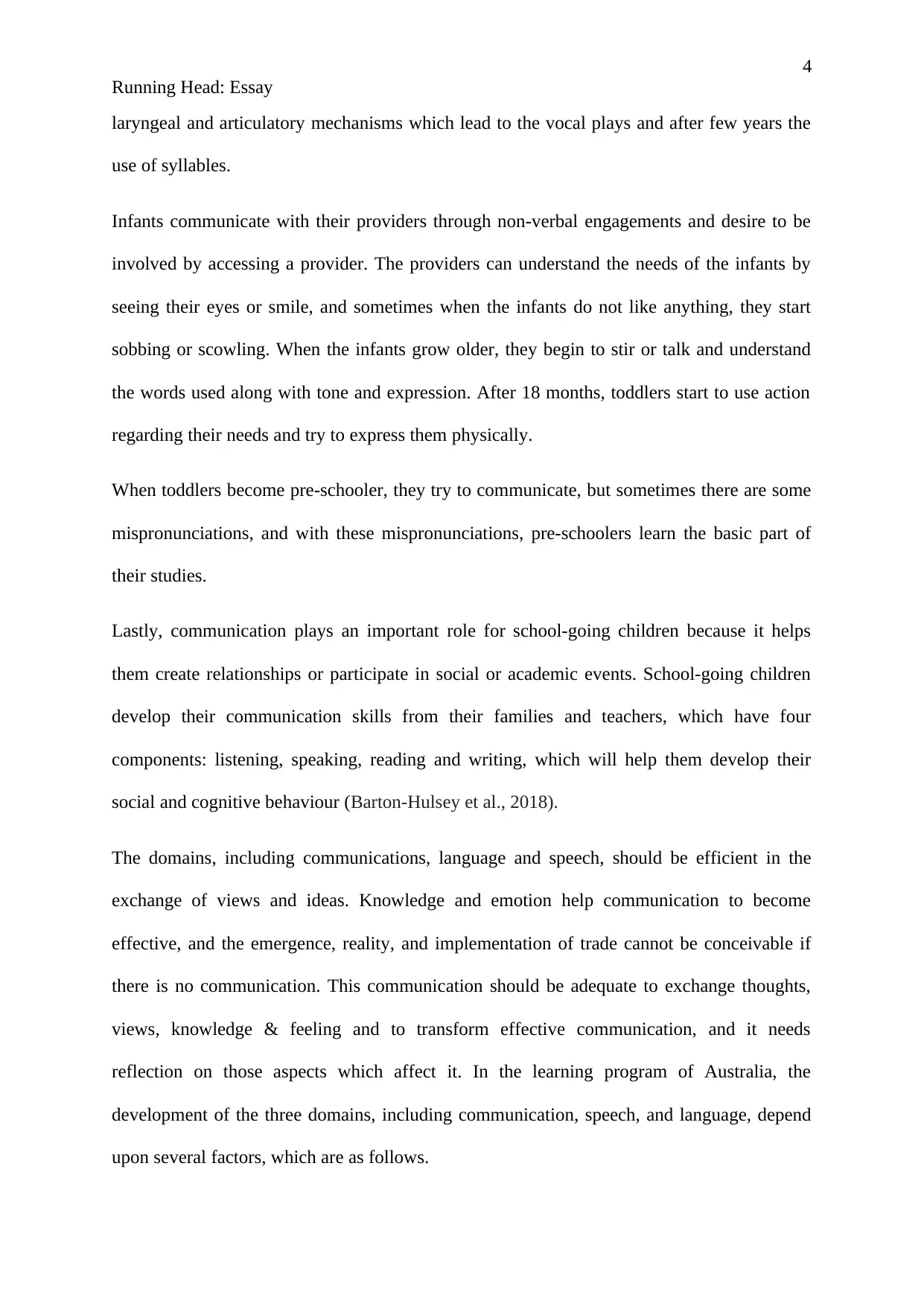
4
Running Head: Essay
laryngeal and articulatory mechanisms which lead to the vocal plays and after few years the
use of syllables.
Infants communicate with their providers through non-verbal engagements and desire to be
involved by accessing a provider. The providers can understand the needs of the infants by
seeing their eyes or smile, and sometimes when the infants do not like anything, they start
sobbing or scowling. When the infants grow older, they begin to stir or talk and understand
the words used along with tone and expression. After 18 months, toddlers start to use action
regarding their needs and try to express them physically.
When toddlers become pre-schooler, they try to communicate, but sometimes there are some
mispronunciations, and with these mispronunciations, pre-schoolers learn the basic part of
their studies.
Lastly, communication plays an important role for school-going children because it helps
them create relationships or participate in social or academic events. School-going children
develop their communication skills from their families and teachers, which have four
components: listening, speaking, reading and writing, which will help them develop their
social and cognitive behaviour (Barton-Hulsey et al., 2018).
The domains, including communications, language and speech, should be efficient in the
exchange of views and ideas. Knowledge and emotion help communication to become
effective, and the emergence, reality, and implementation of trade cannot be conceivable if
there is no communication. This communication should be adequate to exchange thoughts,
views, knowledge & feeling and to transform effective communication, and it needs
reflection on those aspects which affect it. In the learning program of Australia, the
development of the three domains, including communication, speech, and language, depend
upon several factors, which are as follows.
Running Head: Essay
laryngeal and articulatory mechanisms which lead to the vocal plays and after few years the
use of syllables.
Infants communicate with their providers through non-verbal engagements and desire to be
involved by accessing a provider. The providers can understand the needs of the infants by
seeing their eyes or smile, and sometimes when the infants do not like anything, they start
sobbing or scowling. When the infants grow older, they begin to stir or talk and understand
the words used along with tone and expression. After 18 months, toddlers start to use action
regarding their needs and try to express them physically.
When toddlers become pre-schooler, they try to communicate, but sometimes there are some
mispronunciations, and with these mispronunciations, pre-schoolers learn the basic part of
their studies.
Lastly, communication plays an important role for school-going children because it helps
them create relationships or participate in social or academic events. School-going children
develop their communication skills from their families and teachers, which have four
components: listening, speaking, reading and writing, which will help them develop their
social and cognitive behaviour (Barton-Hulsey et al., 2018).
The domains, including communications, language and speech, should be efficient in the
exchange of views and ideas. Knowledge and emotion help communication to become
effective, and the emergence, reality, and implementation of trade cannot be conceivable if
there is no communication. This communication should be adequate to exchange thoughts,
views, knowledge & feeling and to transform effective communication, and it needs
reflection on those aspects which affect it. In the learning program of Australia, the
development of the three domains, including communication, speech, and language, depend
upon several factors, which are as follows.
Paraphrase This Document
Need a fresh take? Get an instant paraphrase of this document with our AI Paraphraser
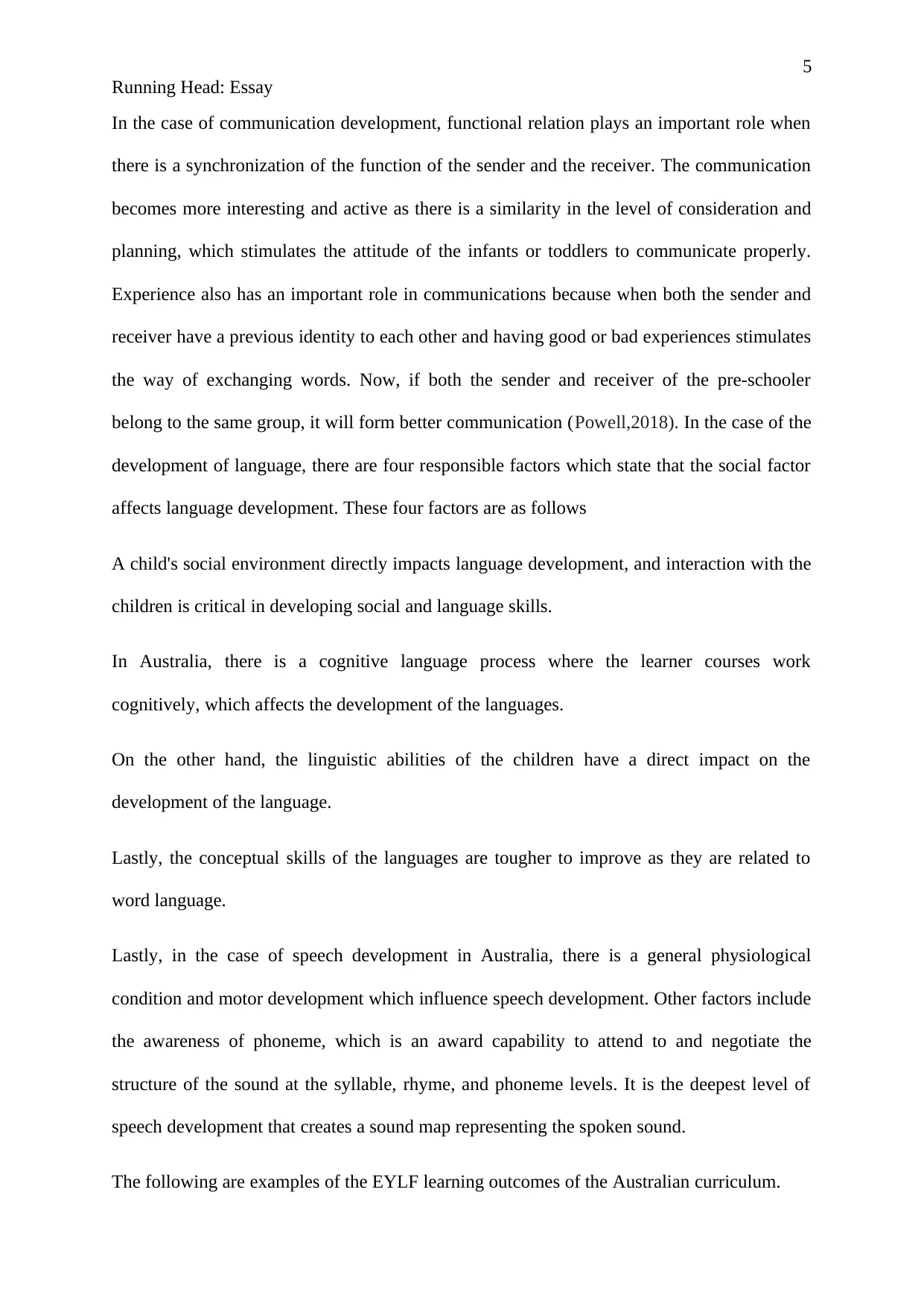
5
Running Head: Essay
In the case of communication development, functional relation plays an important role when
there is a synchronization of the function of the sender and the receiver. The communication
becomes more interesting and active as there is a similarity in the level of consideration and
planning, which stimulates the attitude of the infants or toddlers to communicate properly.
Experience also has an important role in communications because when both the sender and
receiver have a previous identity to each other and having good or bad experiences stimulates
the way of exchanging words. Now, if both the sender and receiver of the pre-schooler
belong to the same group, it will form better communication (Powell,2018). In the case of the
development of language, there are four responsible factors which state that the social factor
affects language development. These four factors are as follows
A child's social environment directly impacts language development, and interaction with the
children is critical in developing social and language skills.
In Australia, there is a cognitive language process where the learner courses work
cognitively, which affects the development of the languages.
On the other hand, the linguistic abilities of the children have a direct impact on the
development of the language.
Lastly, the conceptual skills of the languages are tougher to improve as they are related to
word language.
Lastly, in the case of speech development in Australia, there is a general physiological
condition and motor development which influence speech development. Other factors include
the awareness of phoneme, which is an award capability to attend to and negotiate the
structure of the sound at the syllable, rhyme, and phoneme levels. It is the deepest level of
speech development that creates a sound map representing the spoken sound.
The following are examples of the EYLF learning outcomes of the Australian curriculum.
Running Head: Essay
In the case of communication development, functional relation plays an important role when
there is a synchronization of the function of the sender and the receiver. The communication
becomes more interesting and active as there is a similarity in the level of consideration and
planning, which stimulates the attitude of the infants or toddlers to communicate properly.
Experience also has an important role in communications because when both the sender and
receiver have a previous identity to each other and having good or bad experiences stimulates
the way of exchanging words. Now, if both the sender and receiver of the pre-schooler
belong to the same group, it will form better communication (Powell,2018). In the case of the
development of language, there are four responsible factors which state that the social factor
affects language development. These four factors are as follows
A child's social environment directly impacts language development, and interaction with the
children is critical in developing social and language skills.
In Australia, there is a cognitive language process where the learner courses work
cognitively, which affects the development of the languages.
On the other hand, the linguistic abilities of the children have a direct impact on the
development of the language.
Lastly, the conceptual skills of the languages are tougher to improve as they are related to
word language.
Lastly, in the case of speech development in Australia, there is a general physiological
condition and motor development which influence speech development. Other factors include
the awareness of phoneme, which is an award capability to attend to and negotiate the
structure of the sound at the syllable, rhyme, and phoneme levels. It is the deepest level of
speech development that creates a sound map representing the spoken sound.
The following are examples of the EYLF learning outcomes of the Australian curriculum.
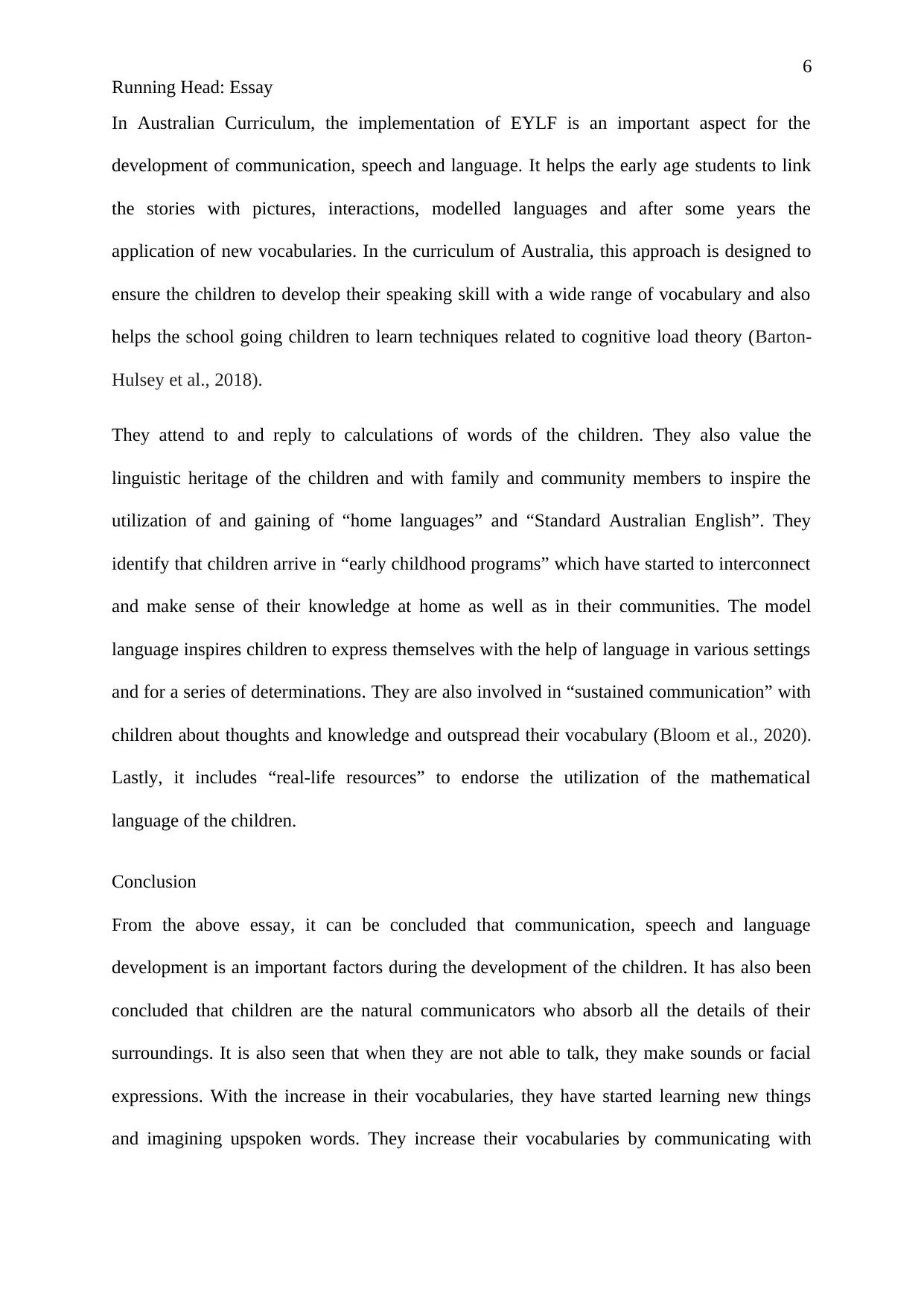
6
Running Head: Essay
In Australian Curriculum, the implementation of EYLF is an important aspect for the
development of communication, speech and language. It helps the early age students to link
the stories with pictures, interactions, modelled languages and after some years the
application of new vocabularies. In the curriculum of Australia, this approach is designed to
ensure the children to develop their speaking skill with a wide range of vocabulary and also
helps the school going children to learn techniques related to cognitive load theory (Barton-
Hulsey et al., 2018).
They attend to and reply to calculations of words of the children. They also value the
linguistic heritage of the children and with family and community members to inspire the
utilization of and gaining of “home languages” and “Standard Australian English”. They
identify that children arrive in “early childhood programs” which have started to interconnect
and make sense of their knowledge at home as well as in their communities. The model
language inspires children to express themselves with the help of language in various settings
and for a series of determinations. They are also involved in “sustained communication” with
children about thoughts and knowledge and outspread their vocabulary (Bloom et al., 2020).
Lastly, it includes “real-life resources” to endorse the utilization of the mathematical
language of the children.
Conclusion
From the above essay, it can be concluded that communication, speech and language
development is an important factors during the development of the children. It has also been
concluded that children are the natural communicators who absorb all the details of their
surroundings. It is also seen that when they are not able to talk, they make sounds or facial
expressions. With the increase in their vocabularies, they have started learning new things
and imagining upspoken words. They increase their vocabularies by communicating with
Running Head: Essay
In Australian Curriculum, the implementation of EYLF is an important aspect for the
development of communication, speech and language. It helps the early age students to link
the stories with pictures, interactions, modelled languages and after some years the
application of new vocabularies. In the curriculum of Australia, this approach is designed to
ensure the children to develop their speaking skill with a wide range of vocabulary and also
helps the school going children to learn techniques related to cognitive load theory (Barton-
Hulsey et al., 2018).
They attend to and reply to calculations of words of the children. They also value the
linguistic heritage of the children and with family and community members to inspire the
utilization of and gaining of “home languages” and “Standard Australian English”. They
identify that children arrive in “early childhood programs” which have started to interconnect
and make sense of their knowledge at home as well as in their communities. The model
language inspires children to express themselves with the help of language in various settings
and for a series of determinations. They are also involved in “sustained communication” with
children about thoughts and knowledge and outspread their vocabulary (Bloom et al., 2020).
Lastly, it includes “real-life resources” to endorse the utilization of the mathematical
language of the children.
Conclusion
From the above essay, it can be concluded that communication, speech and language
development is an important factors during the development of the children. It has also been
concluded that children are the natural communicators who absorb all the details of their
surroundings. It is also seen that when they are not able to talk, they make sounds or facial
expressions. With the increase in their vocabularies, they have started learning new things
and imagining upspoken words. They increase their vocabularies by communicating with
⊘ This is a preview!⊘
Do you want full access?
Subscribe today to unlock all pages.

Trusted by 1+ million students worldwide
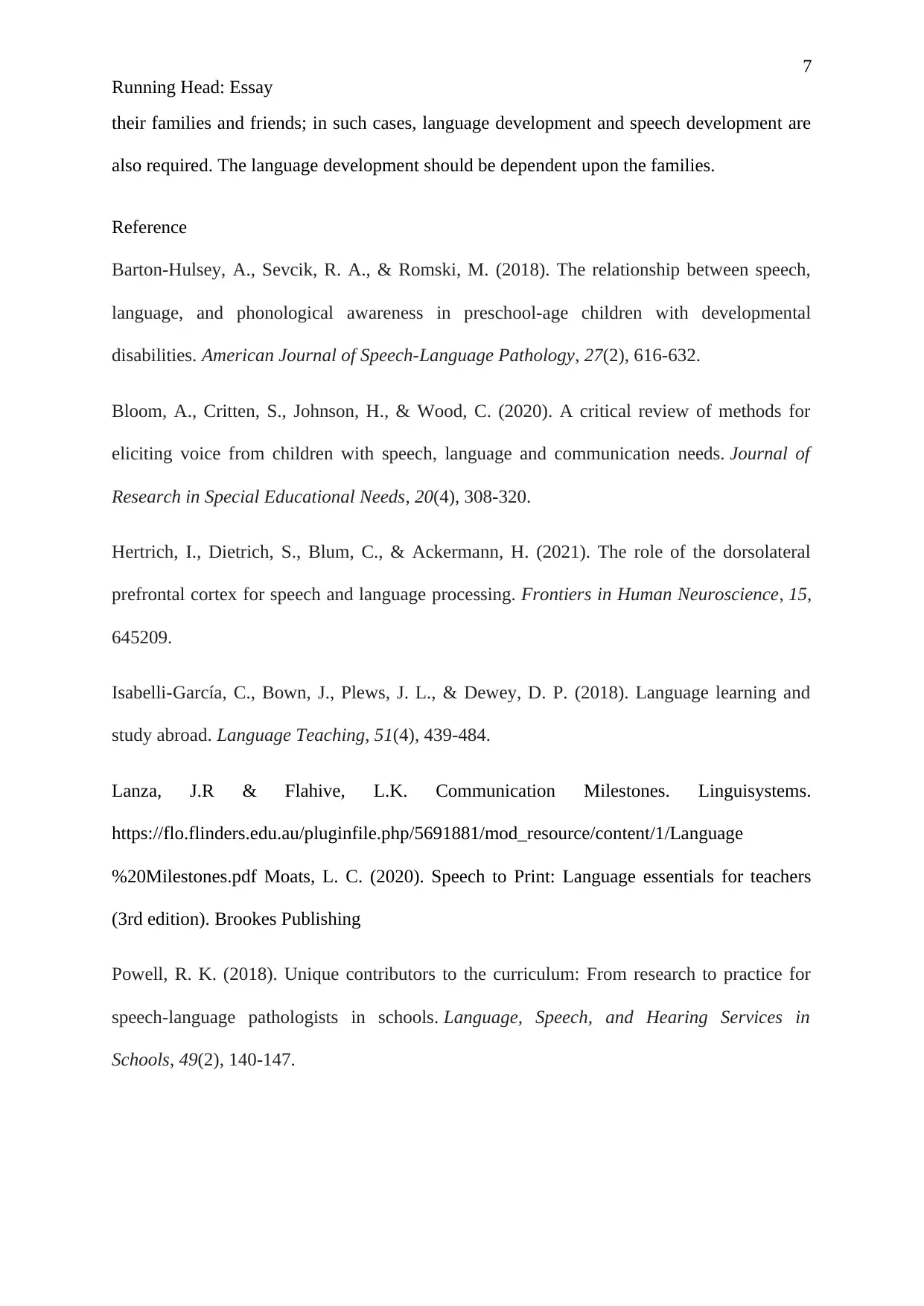
7
Running Head: Essay
their families and friends; in such cases, language development and speech development are
also required. The language development should be dependent upon the families.
Reference
Barton-Hulsey, A., Sevcik, R. A., & Romski, M. (2018). The relationship between speech,
language, and phonological awareness in preschool-age children with developmental
disabilities. American Journal of Speech-Language Pathology, 27(2), 616-632.
Bloom, A., Critten, S., Johnson, H., & Wood, C. (2020). A critical review of methods for
eliciting voice from children with speech, language and communication needs. Journal of
Research in Special Educational Needs, 20(4), 308-320.
Hertrich, I., Dietrich, S., Blum, C., & Ackermann, H. (2021). The role of the dorsolateral
prefrontal cortex for speech and language processing. Frontiers in Human Neuroscience, 15,
645209.
Isabelli-García, C., Bown, J., Plews, J. L., & Dewey, D. P. (2018). Language learning and
study abroad. Language Teaching, 51(4), 439-484.
Lanza, J.R & Flahive, L.K. Communication Milestones. Linguisystems.
https://flo.flinders.edu.au/pluginfile.php/5691881/mod_resource/content/1/Language
%20Milestones.pdf Moats, L. C. (2020). Speech to Print: Language essentials for teachers
(3rd edition). Brookes Publishing
Powell, R. K. (2018). Unique contributors to the curriculum: From research to practice for
speech-language pathologists in schools. Language, Speech, and Hearing Services in
Schools, 49(2), 140-147.
Running Head: Essay
their families and friends; in such cases, language development and speech development are
also required. The language development should be dependent upon the families.
Reference
Barton-Hulsey, A., Sevcik, R. A., & Romski, M. (2018). The relationship between speech,
language, and phonological awareness in preschool-age children with developmental
disabilities. American Journal of Speech-Language Pathology, 27(2), 616-632.
Bloom, A., Critten, S., Johnson, H., & Wood, C. (2020). A critical review of methods for
eliciting voice from children with speech, language and communication needs. Journal of
Research in Special Educational Needs, 20(4), 308-320.
Hertrich, I., Dietrich, S., Blum, C., & Ackermann, H. (2021). The role of the dorsolateral
prefrontal cortex for speech and language processing. Frontiers in Human Neuroscience, 15,
645209.
Isabelli-García, C., Bown, J., Plews, J. L., & Dewey, D. P. (2018). Language learning and
study abroad. Language Teaching, 51(4), 439-484.
Lanza, J.R & Flahive, L.K. Communication Milestones. Linguisystems.
https://flo.flinders.edu.au/pluginfile.php/5691881/mod_resource/content/1/Language
%20Milestones.pdf Moats, L. C. (2020). Speech to Print: Language essentials for teachers
(3rd edition). Brookes Publishing
Powell, R. K. (2018). Unique contributors to the curriculum: From research to practice for
speech-language pathologists in schools. Language, Speech, and Hearing Services in
Schools, 49(2), 140-147.
Paraphrase This Document
Need a fresh take? Get an instant paraphrase of this document with our AI Paraphraser
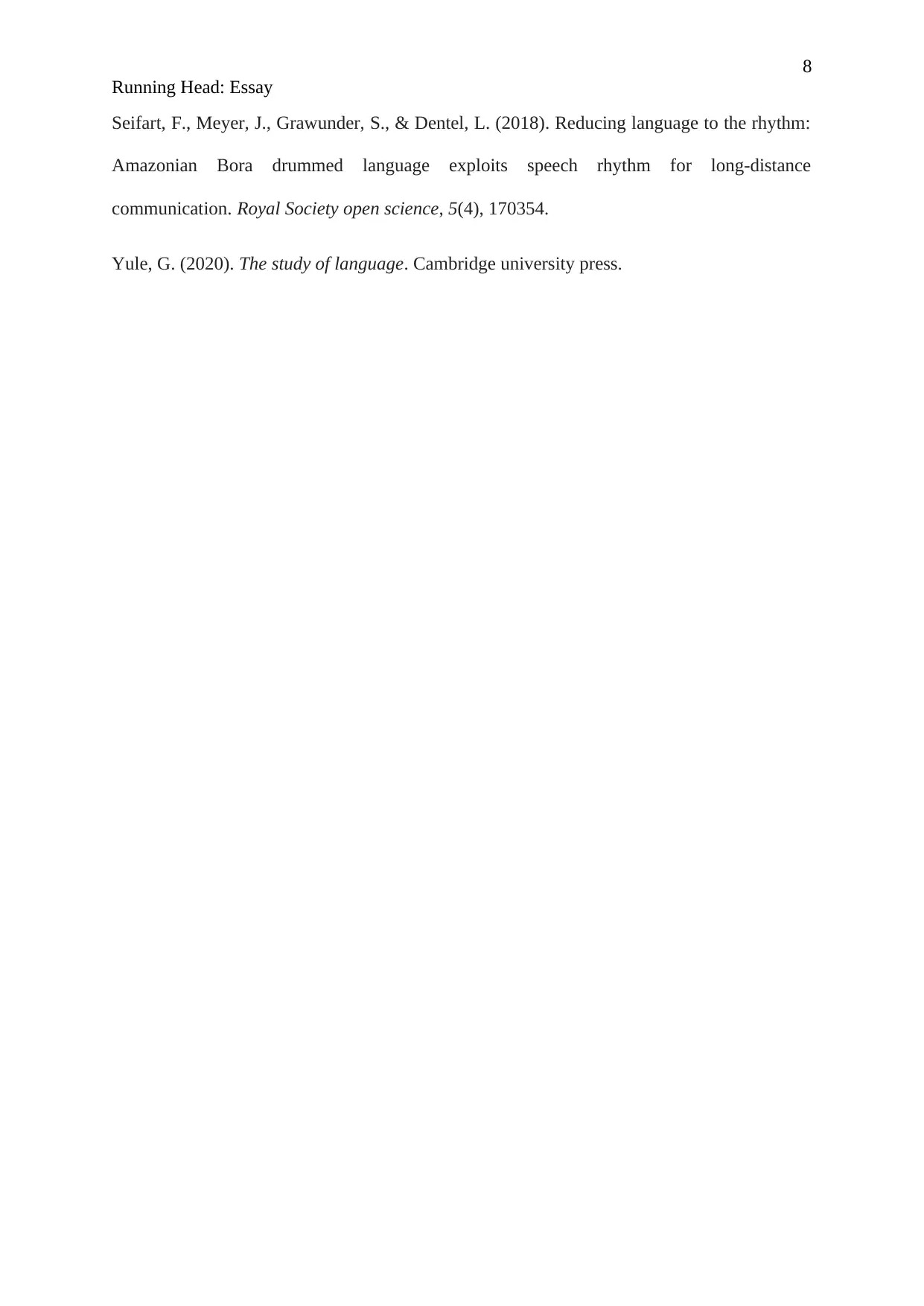
8
Running Head: Essay
Seifart, F., Meyer, J., Grawunder, S., & Dentel, L. (2018). Reducing language to the rhythm:
Amazonian Bora drummed language exploits speech rhythm for long-distance
communication. Royal Society open science, 5(4), 170354.
Yule, G. (2020). The study of language. Cambridge university press.
Running Head: Essay
Seifart, F., Meyer, J., Grawunder, S., & Dentel, L. (2018). Reducing language to the rhythm:
Amazonian Bora drummed language exploits speech rhythm for long-distance
communication. Royal Society open science, 5(4), 170354.
Yule, G. (2020). The study of language. Cambridge university press.
1 out of 8
Related Documents
Your All-in-One AI-Powered Toolkit for Academic Success.
+13062052269
info@desklib.com
Available 24*7 on WhatsApp / Email
![[object Object]](/_next/static/media/star-bottom.7253800d.svg)
Unlock your academic potential
Copyright © 2020–2025 A2Z Services. All Rights Reserved. Developed and managed by ZUCOL.





